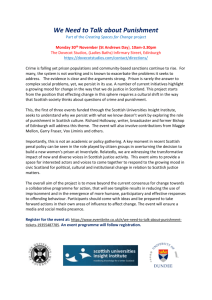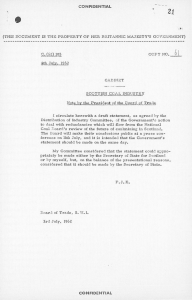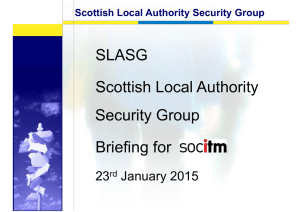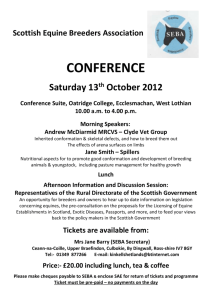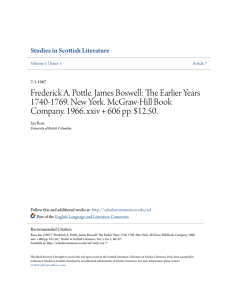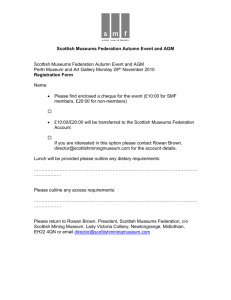Learning from other disciplines and sectors
advertisement
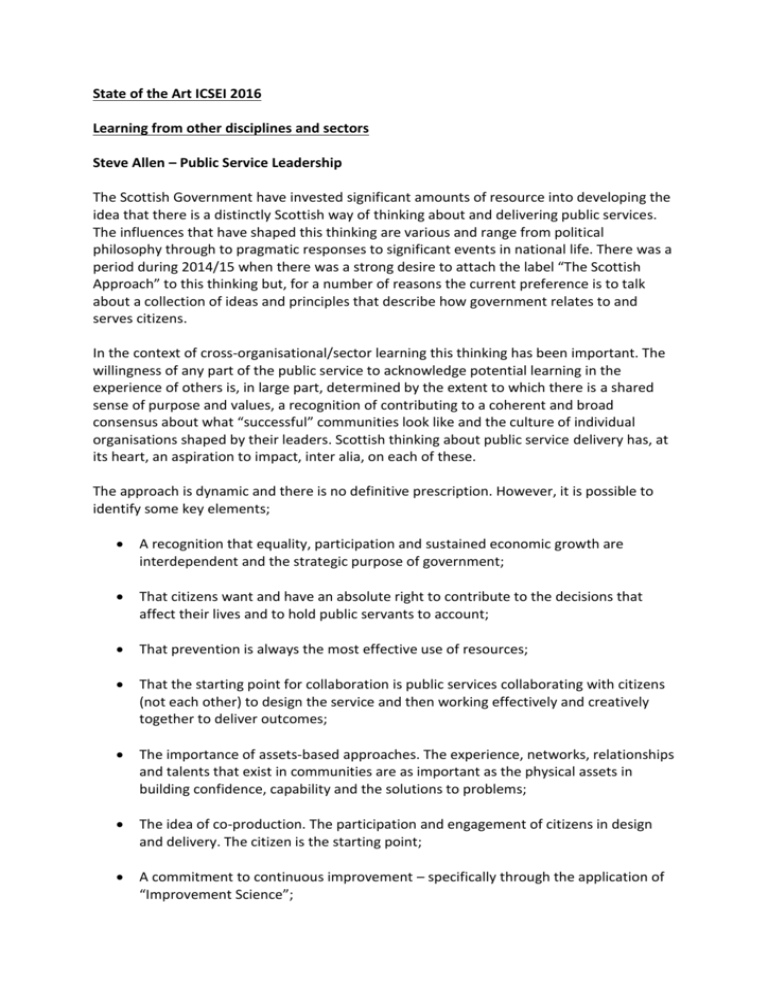
State of the Art ICSEI 2016 Learning from other disciplines and sectors Steve Allen – Public Service Leadership The Scottish Government have invested significant amounts of resource into developing the idea that there is a distinctly Scottish way of thinking about and delivering public services. The influences that have shaped this thinking are various and range from political philosophy through to pragmatic responses to significant events in national life. There was a period during 2014/15 when there was a strong desire to attach the label “The Scottish Approach” to this thinking but, for a number of reasons the current preference is to talk about a collection of ideas and principles that describe how government relates to and serves citizens. In the context of cross-organisational/sector learning this thinking has been important. The willingness of any part of the public service to acknowledge potential learning in the experience of others is, in large part, determined by the extent to which there is a shared sense of purpose and values, a recognition of contributing to a coherent and broad consensus about what “successful” communities look like and the culture of individual organisations shaped by their leaders. Scottish thinking about public service delivery has, at its heart, an aspiration to impact, inter alia, on each of these. The approach is dynamic and there is no definitive prescription. However, it is possible to identify some key elements; A recognition that equality, participation and sustained economic growth are interdependent and the strategic purpose of government; That citizens want and have an absolute right to contribute to the decisions that affect their lives and to hold public servants to account; That prevention is always the most effective use of resources; That the starting point for collaboration is public services collaborating with citizens (not each other) to design the service and then working effectively and creatively together to deliver outcomes; The importance of assets-based approaches. The experience, networks, relationships and talents that exist in communities are as important as the physical assets in building confidence, capability and the solutions to problems; The idea of co-production. The participation and engagement of citizens in design and delivery. The citizen is the starting point; A commitment to continuous improvement – specifically through the application of “Improvement Science”; There is no one solution that meets the needs of every community. Locallyappropriate solutions consistent with a shared set of principles; Budget constraints are not a driver of change in the public service, they are simply the context in which reform is occurring; The public service includes the public sector, the third sector and the private sector delivering public services. The important point is the invitation to all public service organisations to understand their role in the wider context of nation-shaping. This type of public service requires a particular type of leadership, characterised by a broad and deep understanding of the role of public service as a whole system. It requires the confidence to empower and resource leaders at a local level to innovate and respond to local environments. It requires leaders who understand and practice genuine engagement and who have a sophisticated and long-term view about the wider outcomes citizens and communities are seeking. There needs to be a recognition of the significant investment required to train and develop staff at all levels of organisations to work in a different, more responsive, less prescriptive way and systems and processes need to select, promote and reward those who operate successfully in the new paradigm. There are challenges to be met. They include the political imperative to short term, demonstrable achievement. This manifests in target-driven performance regimes that distort behaviour, divert resources and can strip people-centred, vocational work of its essential meaning. Budget constraints push some leaders into a reductionist approach that talks of “core functions”, reduces the commitment to partnership, encourages reactive rather than preventative activity and devalues any activity for which there is not a “measure”. The continuing challenges around representation and diversity run the risk of being regarded as yesterday’s problem. The aspiration for public service can only be effectively met if talent is harnessed, if different perspectives and experiences shape the debates, if meaningful challenge is welcomed. The rhetoric is good but is there an understanding of and willingness to have a public discussion about dealing with institutionalised discrimination? Increasingly it is recognised that effective leaders are those with highly developed emotional intelligence, who model compassion and humility, who see their role as being to coach and develop others. Leading through the building and maintenance of highly effective relationships. Are these really the criteria upon which senior leaders are selected? Are these typically the behaviours they display? Is it still commonplace for bullying to be dressed up as leadership and that bullying to be known about and not addressed? Is it still all about “delivery”? Is leadership still a competitive sport in which putting your organisation ahead of others, the satisfaction of ego, is more important than the lived daily experience of our citizens? Whilst I have described the context from a Scottish perspective I am confident that the themes will be consistent across numerous jurisdictions. The posture for public service leaders needs to be more about looking up and out than looking down and in. Education, as a sector, cannot respond to these challenges or this context in isolation, any more than any other. The questions may be as much about how, across the public service we learn with each other as about what we learn from each other.


